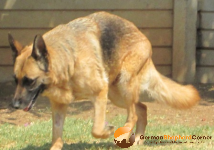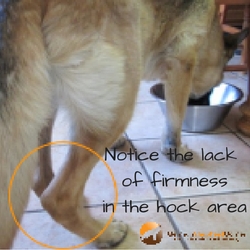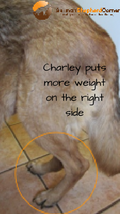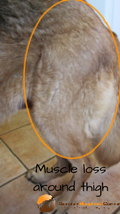
Charley’s story
My Charley has Hip Dysplasia (HD). She’s turning 9 years old on the 10th of October this year.
I knew Charley had HD when I decided to invite her into my life. But it didn’t matter, I loved her from the moment I saw her.
The breeder said her hips fall into the borderline category and she might never present with HD symptoms. What he failed to mention is that she had a fracture in her left hip. I suspect he was the cause of it. I won’t go into reasons for my suspicions. Let’s just say he’s the kind of person who should not be allowed near animals.
Charley has always been an active dog. She was always lean, fast moving and agile and adored long rambling walks. I mean she helped me raise Zeze and Lexi from small pups to adults.
But over time, I noticed her movement become more restricted, with increased limping.
Despite her abusive past, Charley has always been a happy dog, but at one stage I noticed signs of depression…
- No more interest or drive for the things she loved doing
Refusing the long walks she loved so much
She avoided playing outside with her young siblings
She’d spend most of the day indoors even in summer
Chasing birds off ‘her’ back yard disinterested her
I knew I had to help her!
So I set out on a mission to create an all natural treatment plan specific to Charley.
Today, I’ll share with you what I’ve found that works for Charley. And, how you can put together a similar treatment plan for your GSD.
But more about Charley and how to help German Shepherds with hip problems in a minute…

First I want to share some facts with you…
If you’re the lucky owner of a German Shepherd, or you’re just about to become a GSD mamma or pappa, you already know there is a chance yours might already have, or develop Hip Dysplasia.
What is Hip Dysplasia and why are GSDs prone to it?
Hip Dysplasia is a genetically inherited disease where the femur sits too shallow and doesn’t fit snug in the hip socket.
Depending on the grade it can be painful, and in most cases HD sets the stage for arthritis in later life. In severe cases, this can happen early on, even in puppy stages.
It’s believed that this disease stems from inbreeding during the breed’s early life. It was a case of catch 22 back then. Because the goal of inbreeding was to preserve other traits in the breed.
But I believe if the early breeders of the GSD knew then what we know now, they would have done things differently.
Also, unfortunately, show breeders often breed their German Shepherds with overly angulated hind quarters. The reason for this angulation is to achieve a desirable ‘stack’ or stance during showing.
How to Recognize Symptoms of Hip Dysplasia
These are the main signs of HD, but it’s not to say that all of them will be present at the same time.
- General pain and discomfort
Keeping the hind legs close together to counter poor balance
‘Bunny hopping’ when running – instead of the signature ‘trot’ of the GSD
Struggling to get up after lying down
Loss of muscle tone (atrophy)
Reluctance to use full range of motion in hind legs
General lameness
Whining or crying when getting up quickly
Not as excited to enjoy regular physical activities
Visible signs of depression
Often, dogs will nibble at their hind legs. I’m not 100% sure why, but my guess the nibbling helps with pain relief.

How Prone Are German Shepherds to Hip Dysplasia?
It’s interesting to note that research by The Orthopedic Foundation for Animals ranks the GSD 39th in their research on breed specific HD. And this is not from a small sample! The evaluations run from January 1974 to December 2015. With each breed having at least 100 evaluations during that time.
The GSD had 115933 evaluations in total.
What’s also interesting is that the cases of HD have remained pretty much the same during this time. In my opinion, it’s the popularity of the breed that makes it seem like the GSD is right at the top of the list.
How bad does it get?
There are different grades of HD, but I won’t go into them here. If you want to know more and see examples, this is an excellent resource.
Charley has Fast Normal hips – which is borderline. The grade always stays the same. But as they age, their hips will deteriorate. The fact that Charley also has an old hip injury contributes to the deterioration of her hips.
Okay, now let’s look at how we can help our beloved German Shepherds…
How to help German Shepherds with hip problems
Find an Ethical Breeder
An ethical breeder will breed from HD free adults. Of course, there’s no guarantee this will eliminate the risk of HD. But it can reduce the odds.
In Germany, dogs must certified HD free before they are used in a breeding pair.
This is not mandatory in the U.S. And as far as I know HD screening is not required in the U.K. either. But a reputable breeder should be able to provide you with this information.
Early Detection
Early detection gives you more opportunities to help slow down the degeneration.
Charley was 5 when she came into my life. So I didn’t have the privilege of having her as a pup. If I had, I could have started with a host of treatments to help her more.
The only way to be 100% sure of HD is through an x-ray. These are done anywhere from the age of 6 months. But in most cases, from 12 months.
Maintain Healthy Weight
This is the most important part of helping German Shepherds with hip problems.
Keeping your GSD’s weight at the lower end of the weight range will reduce stress on the hips.
Charley weighs in at 28kg – that’s about 64lbs. She’s a medium, compact German Shepherd, and a female. So her weight is perfect for her size.
Controlling weight is a two-fold plan – exercise and diet.
Healthy Diet
Keeping your GSD on a healthy diet will naturally help maintain a healthy weight.
The ideal diet should be high in protein and calcium. Low in fats and grains like starch, soy and wheat is ideal.
Because the muscles in their hind quarters will atrophy because they’re not used properly, protein is essential.
And grains like I mentioned, slow down digestion which contributes to weight gain.
I feed all my dogs a 100% raw diet. But you could feed a home cooked diet.
Or, if you prefer feeding kibble, there are some great alternatives with high protein, lower fat content and none of those bad grains I mentioned.
Older dogs like Charley are less active and need less energy. So, keep an eye on portions and watch their weight.
Natural Supplements
Supplements are one of the cornerstones of helping Charley stay mobile and provide long-term pain control.
If your German Shepherd suffers from HD, I definitely recommend using them.
Stay far away from Non Steroidal Anti Inflammatory Drugs (NSAIDS) and steroids!
In most cases this is the standard treatment recommended by vets. It might relieve your dog’s pain in the short term.
But these drugs can actually destroy joints and cartilage. Which is counter productive.
They also cause nausea and vomiting. Not to mention the long term toxic effects…
They destroy the kidneys, can cause liver failure. And bleeding of the stomach and intestines.
Think about it…
Why should your German Shepherd suffer with HD and endure the destruction of his or her internal organs too.
Natural supplements do take longer to begin their magical work. But once you’ve found the right one it’s well worth the wait.
What I Use
I’ve tried a bunch of different supplements. And for the last 20 weeks I’ve used Best Vets Glycan Plus Glucosamine and I’ve seen a marked improvement. I noticed it at around week 4, and at first I thought I was imagining it, until my husband commented on Charley’s improved range of motion, reduced limping and increased interest in playing.
Whoop, Whoop!!
I chose this supplement for a few reasons:
First, it’s shellfish free
I don’t give my dogs any seafood products. Why? Because our oceans are filled with radioactive toxins. Think Fukushima here. So it’s important for me to not add more toxins to Charley’s body.
I like the fact that all the ingredients in this supplement are found naturally in a healthy body
Glucosamine HCL is found naturally in healthy cartilage and in the fluid around joints. It has anti inflammatory abilities and can also help rebuild cartilage.
Chondroitins are great for pain relief. In studies done on humans with various grades of arthritis, there was moderate pain relief and shorter periods of morning stiffness.
Hyaluronic Acid (HA) is found in the body’s synovial fluids, especially around the hips and shoulders. From studies it has been proposed that HD may occur because of a genetic deficiency of HA in these fluids.
Cetyl M is a fatty acid first found in albino mice, and in laboratory tests it was discovered that these mice are immune to arthritis. It also has anti inflammatory properties, and scientist believe it’s able to reprogram faulty cells that cause arthritis.
MSM also has anti inflammatory power. It helps decrease pain and aids in healing muscles. It also limits the deterioration of cartilage and helps to form connective tissue.
The EsterC found in Best Vets Glycan Plus Glucosamine is different to regular Vit C. It’s not ascorbic so it’s easy on the tummy and intestines. And it helps improves absorption.
And the high levels of bioflavinoids enhance white blood cells. Making them more effective at fighting toxins and abnormalities.
Using Best Vets Glycan Plus Glucosamine
In weeks 1 to 4 you give a ‘loading’ dose. Which is double the suggested maintenance dose.
This is to help build up the power of the natural supplement. It was by the end of this 4 week period that I saw real improvements in Charley.
After 4 weeks you give a long term ‘maintenance dose’ which is half of the loading dose.
In Charley’s case that means;
Loading dose: 4 chew tabs – 2 in the morning and 2 in the evening.
Maintenance dose: 2 chew tabs – 1 in the morning and 1 in the evening.
Always give on a full stomach. I just drop the chews in Charley’s food.
Light Exercise
Atrophy is the degeneration of the muscles around the hips. It happens because the hips are not used with their full range of motion.
Light exercise will help keep the muscles working and prevent them from seizing up.
Short, gentle walks are a great way to keep things moving. Remember, that walking is an impact exercise so be sure to keep the sessions short.
And stick to surfaces that have some ‘give’ like grass, soft soil paths or the natural mulch paths found in woody areas. Avoid sidewalks, concrete has no give under the paws. Tar has more give than concrete, but my advice is to avoid it too.
If the symptoms get worse, stop walking exercises and find other more light exercise.
Our large yard with trees and shrubs are a great place for Charley to take short walks and have the occasional short bunny hop/trot if she feels up to it. To keep things interesting I open up other areas for her when I get home from work. This keeps her interested and supports her canine desire to explore.
But when it comes to exercise, hydrotherapy takes the cake. Your GSD is weightless in the water which relieves the pressure off the hips. It helps to build the hip muscles without the impact of walking. Unfortunately, hydrotherapy is expensive and might not be available in your local area.
An alternative is to use a swimming pool. Of course your dog will need to like swimming for this to be effective. And it’s best if the water is warm. Cold water will stiffen the muscles.
Sadly, Charley is afraid of water. She won’t go near our swimming pool. So this is out of the question for us.
Accupressure Massage
Massage is another effective tool I use to help Charley. Daily massage moves the blood through the muscles and eases tension. This naturally manages pain too.
I learned about massage in a couple of weeks by watching a bunch of great videos on Expert Village. Go to YouTube and search for “Dog Acupressure for Hip Dysplasia.”
I allow Charley to decide what she needs massaged and for how long. She’ll offer her hind quarter for massage. But I’m careful to respect her pain tolerance on a day to day basis. On days when she’s more uncomfortable like when it’s cold or raining, she might want more.

Practical Steps You can Take
Making life easier for your German Shepherd with HD is as simple as asking yourself; “what will make it easier for my dog to move around?”
We have tiled and wooden floors. These floor surfaces can be slippery and prevent your GSD from getting a good grip for walking.
For Charley, I’ve laid down large rugs all over the house with non slip rug pads underneath. This makes her more confident to move around the house.
For more comfort and support you should consider buying your dog an orthopedic bed. Orthopedic beds are made from memory foam or gel, or both. And unlike regular dog beds the foam molds to the body.
There are 2 main benefits to this:
- Firm support for your dogs weaker hind quarters
Soft and warm place to rest or sleep
Cold surfaces will stiffen the muscles, aggravate the pain. Making it difficult for your dog to get up.
I wanted the Furhaven Pet Orthopedic Mattress from Amazon, but the shipping costs to South Africa are 9 times the selling price. The local options I had weren’t great quality. So I had one made.
Walking Wheelchairs
Many German Shepherd owners have changed the life of their dog living with HD by introducing them to a Walking Wheelchair.
These handy wheelchairs help dogs to play, run and explore and live a happy, healthy life. Good quality wheelchairs are bought already made and are height, length and width adjustable.
Walking Wheelchairs are more popular than one would imagine. I’ve even found a Facebook group that provides plans to build a Walking Wheelchair at home.
I strongly considered a Walking Wheelchair for Charley. But she’s had an awful past which has made her timid of most things. I have learned to respect her boundaries and I know a Walking Wheelchair will cause her unhappiness. So it’s not an option for us.
Hip Surgery
A recent x-ray showed continued degeneration of Charley’s left hip, made worse by that old fracture. The strain this is putting on her right hip has brought me to the decision to go ahead with hip surgery.
There are several different hip surgeries available. But because Charley is older and her weight is controlled, our vet suggested a Femoral Head and Neck Excision.
In a nut shell, the head of the femur is sliced off. Then some fat is taken and worked into the hip socket. After this, the femur is placed at the correct depth and angle back into the socket. Over time and with proper healing this setup forms a new, artificial joint.
This surgery will improve Charley’s life and give us at least 3 to 4 more years together. So, the decision is really a no-brainer for me.
Charley is booked in for her surgery in early December, and Hindy has been kind enough to allow me to share an update post-op.
While we wait for the surgery, I’m educating myself on post-op recover treatments and I look forward to sharing her positive results and detail her post-op recovery.
This post was kindly written by Rosemary Dowell, the founder of German Shepherd Corner. She lives in Sunny South Africa with her husband, 2 German Shepherds Charley & Zeze and her limited edition pup, Lexi. If she’s not inventing a new dish in her kitchen, pouring over the latest studies on dog behaviour or playing puzzle games with her dogs, you’ll find Rosemary at German Shepherd Corner, helping GSD owners train their dogs using force-free, science-based methods. You can connect with Rosemary on Twitter @GSD_Corner.

 The Loss of a Pet: Will You Be There at The End?
The Loss of a Pet: Will You Be There at The End?
So great to hear about your natural approach to help Charley’s HD! I transitioned to raw feeding 18 months ago after my Boxer mix Missy was diagnosed with cancer. She has since then kicked cancer’s butt and has never been healthier!
Hi Barbara, Hindy here, I will pass on your comment to Rosemary. That’s incredible to hear, I have never fed my pets a raw diet, but I do hear incredible stories of markedly improved health as a result.
Hi Hindy, thank you 🙂 I had as well, so I figured I’d give it a shot since it couldn’t get any worse than having cancer. And sure enough, it worked!!
Really fantastic to hear.
Hi Hindy and Barbra,
I hope it’s okay to chime in?!
It’s so lovely to hear of another pet parent having success with raw feeding! It’s so cool that Missy kicked cancer!
My decision to make the change came over a period of 6 months of research and thousands spent dealing with colitis, hot spots, yeast infections, vomiting, diarrhea and a host of other ailments.
My male Zeze suffers from Endocrine Pancreatic Insufficiency which is a terrible disease. Basically the dog wastes away from the inside since the body cannot digest or make use the nutrients from food.
Since he’s on a raw diet, he’s never had a problem eating. He used to refuse to eat and had terrible troubles with an overgrowth of bacteria in his stomach. All symptoms of EPI.
I’ve been feeding raw for over 2 years now and have never looked back!
🙂
Thanks for chiming in Rosemary!! My dog Red is about 15, and has some health issues…all managed with drugs. She’s doing really well, but I would love to go a more holistic route, and even perhaps raw food. The problem is her condition is a careful balance and I don’t want to do anything to upset it. I have a fantastic vet, but not holistic and there is no one anywhere near where I live. It’s always incredible for me to hear about health issues that have cleared up due to a raw food diet and holistic care.
Hi Rosemary, I am really sorry to hear about Zeze’s disease, yet SO STOKED to hear about yet another raw food success story! Mother nature really knows best. Do you feed according to the PREY model or a BARF diet?
Hi Barbra,
I only saw this comment now.
I feed a BARF diet. I tried PREY but neither of my pups liked it. I substitute 2 meals a week with raw meaty bones. So they get all the goodness of chewing and ripping at meat and bone.
Cool! I’m somewhere in the middle – I buy from different online retailers – 2 add veggies/fruit, one doesn’t, so the pups get veggies/fruit only with some of their meals. I feed raw meaty bones a few times per week for the same reason you do. It’s such a great natural way of keeping their pearlies clean. I haven’t tried feeding whole prey yet – the closest we’ve come to were duck heads. Both pups were very curious about their respective head and sniffed them for probably a whole minute before picking them up out of the bowl. They didn’t last very long after that 😉 A few crunches and they were history!
We have a 17years old dog which he can hardly walk because he can no longer control of himself.It breaks our hearts to see him this way. We have seek our vet doctor and prescribed him vitamins and also pain reliever but with a certain period only because it might harm his liver. Every time,he walks by himself, we always pat him with happiness and say “you can still make it.”
I’m so sorry to hear that Dale. The worst thing is to see our dogs in pain, and of course the only thing that matters is quality of life when it comes to our pets. As hard as it is to say goodbye, allowing them to suffer is never an option. Have you tried acupuncture? Yes there can be serious side effects to organs from some medications, but acupuncture can be very effective in many situations. You can use it in conjunction with the pain relief, and it can be possible to even reduce the amount of medication because of it. Of course every case is different so if your vet doesn’t offer it perhaps there is a holistic vet in your area you can have a chat with? Good luck and let me know how things go.